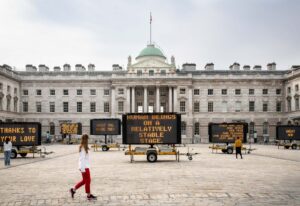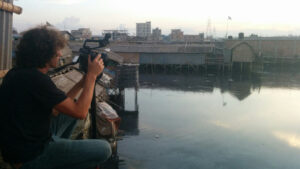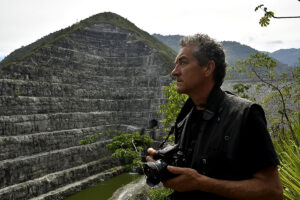
Justin Brice – Environmental Artist
Environmental artist Justin Brice encourages others to take a critical look at the relationship between humans and the planet.
France
MOOD OF LIVING April 20, 2016
Bulgarian artist, Albert Hadjiganev, moved to France to pursue his dream of becoming an artist at the age of 28. Hadjiganev’s sensitivity to nature, alongside his knowledge of art history and fine art technique, inspires a masterful and a mysterious collection of landscapes.
Hadjiganev’s paintings have been displayed in countless galleries worldwide, including the coveted Grand Prix de Peinture of the Académie des Beaux-Arts in 1989, the Prix du Gouvernement Princier at the Salon International d’Art Contemporain in Monaco in 1990 and, most recently, a solo exhibit in New York City at the Axelle Fine Arts Gallery in 2015.
Mood of Living: Where is your hometown?
Albert Hadjiganev: Sevlievo, Bulgaria. It’s a small area in South-East Europe.
MoL: Before you were an artist, you were?
AH: Sports event planner. Housekeeper. Photographer. Docker. Sign painter. Shoe designer. Factory worker. Night watcher. Delivery driver. Museum guard… I think I have forgotten some.
MoL: What inspired you to change occupations and become an artist?
AH: Actually, all those jobs helped me survive while I was studying, drawing and painting.
MoL: When did you first realize you wanted to be and could be an artist?
AH: When I was 21 or 22.
MoL: What kind of awards or honors have you received?
AH: Great Prize of Painting for the Beaux-Arts Academy (Grand Prix de Peinture de l’Académie des Beaux-Arts) in 1989 (unfortunately, this award doesn’t exist in France anymore). Prize of the Princely Government (Le Prix de Gouvernement Princier) in 1990 (during the Contemporary Art Fair of Monte Carlo). After that, I never applied for a prize again. I was too afraid of becoming a “prize beast” and not enough an artist.
MoL: What mediums do you tend to work in?
AH: Nothing very out of the ordinary: pencils for sketches, oil pastel or water-soluble pastel for more thorough sketches and oil for paintings.
MoL: How would you describe your art and your creative process? Do you think your art could be categorized into a certain movement?
AH: Of course, since some people’s work is to place artists into categories. Perhaps the public needs this to find its way. However, I never recognize myself in the categories where they place me. I believe [they have made me out] to be a kind of “post-retro-neo realist”, but actually I don’t really care about the tag they put on me. To me, a painting is pretty or not. It can come from whatever era or whichever artistic movement. It can be worth millions, but if it doesn’t touch you, it isn’t worth anything. Not even the price of the material. Then go on your way and visit the next gallery.
MoL: Your method of creation relies heavily on an underlying sense of darkness within the peacefulness of the scene. Can you please describe your thought process.
AH: A big blue sky is more cheerful than a sunset. However, most of us love sunset. Why? Personally, I don’t know anything brighter that a self-portrait by Rembrandt that emerges from darkness. So I conclude that we need darkness to exhale or suggest the light. It is that simple.
MoL: Did you grow up in an artistic environment? What molded your artistic capabilities?
AH: My dad was an artist and I grew up with the smell of turpentine and his art books. I also had some natural drawing abilities, it’s true, but that was not the decisive point. My artistic abilities started to truly develop later, when I became aware that painting was the only thing that allows me to say what I want, when I want and however I want.
MoL: Who inspires you? Why?
AH: My models in art date back to at least a century and a half ago. They are all the great masters, from Titian to Courbet, through Velasquez and from Claude Le Lorrain to Corot, through Turner. The list is very long. After that, during the 20th century, it is a championship, a sort of race where the extraordinary and the flashy become the standards and result in all the “non-art” that we know today. I am 61 and one can think that I say this because I am old and outdated, but I see around me more and more talented young painters between ages 30 and 40 who think like me and refuse the standards imposed by official art called “contemporary”.
MoL: What type of training in art do you have? Are you currently interested in exploring any new art techniques?
AH: I graduated from École Nationale Supérieure des Beaux-Arts of Paris, but I believe that I learned way more by frequenting other workshops and museums than this school. As for new techniques and forms of art, I am not looking anymore. I spent years to tame the one that I possess. Now I try to become more accomplished with it.
MoL: Ultimately, what message do you try to convey to your audience through your artwork?
AH: No message. If one finds a part of oneself or one’s real-life experience in my paintings, my job is done. The message is said. Otherwise, one goes one’s way… and me too.
MoL: Where do you get your inspiration?
AH: All around me. The beautiful can be everywhere; you just need to be available to see it.
MoL: We tend to find that people who create beautiful work, create beautiful homes. Do you take time to decorate your home in a certain way?
AH: Not at all. I live in a village house from the end of the 17th century, where lots of modifications were made during the past three centuries. The furnishing is a little bit odd and rather owed to randomness, than to an aesthetic search. The only elements of decoration that I bring are my paintings, which I try on my walls before exhibiting them.
MoL: Do you cook? Do you entertain?
AH: Yes, as much as I can. I love that my friends feel at home in my place and I noticed that there is nothing better that a delicious, traditional meal with a good Bourgogne for everyone to be comfortable.
MoL: Where do you see yourself in 10 years?
AH: Probably in Spain, pursuing the lights produced by the arid landscape over there.
MoL: What is your favorite quote?
AH: “La meilleure façon de marcher c’est encore la nôtre : – c’est de mettre un pied devant l’autre et de recommencer” “The best way to walk is ours: it is to put one foot in front of the other and then to start again” (A french boy-scout song).
MoL: How do you achieve peace of mind?
AH: I have never reached it, but I find comfort in the idea that my paintings help some people to reach it…
MoL: What is your favorite hobby?
AH: My work.
MoL: Where is your favorite place to travel?
AH: All of France, Italy and, more recently, Spain.
MoL: What period of art do you most admire? Why?
AH: I admire more the Italian Cinquecento, but I feel closer to the French 19th century.
MoL: If you could speak to any artist, dead or alive, whom would it be and why?
AH: Frédéric Chopin, Sergueï Rachmaninov, Tom Waits. For the emotion they give me. The list could be very long, but these are the three names that come to me immediately. I should add, however, painters Giorgio Morandi and Zoran Music because they went through the 20th century without being corrupt by all of the “-ism”. And since this is all in theory, I wouldn’t hate to share some drinks with Maupassant, Jim Harrison or Amin Maalouf.
Photography courtesy by Albert Hadjiganev

Environmental artist Justin Brice encourages others to take a critical look at the relationship between humans and the planet.

Internationally recognized filmmaker Andrew Morgan focuses on telling stories for a better tomorrow for various film and new media projects.

Throughout his work with Ala Plástica and Casa Río Lab, environmental activist and artist Alejandro Meitin unites social engagement, art, and sustainability.